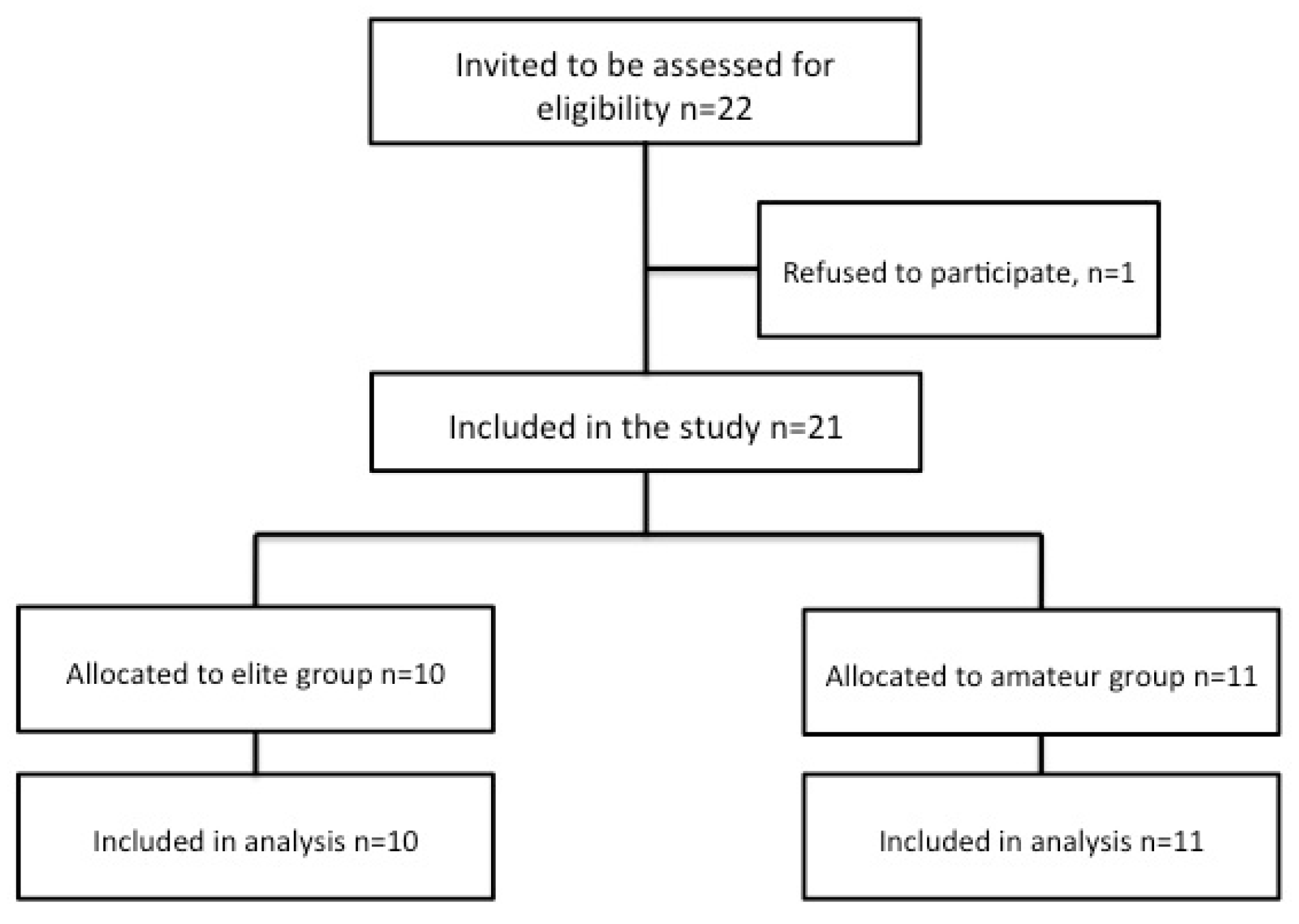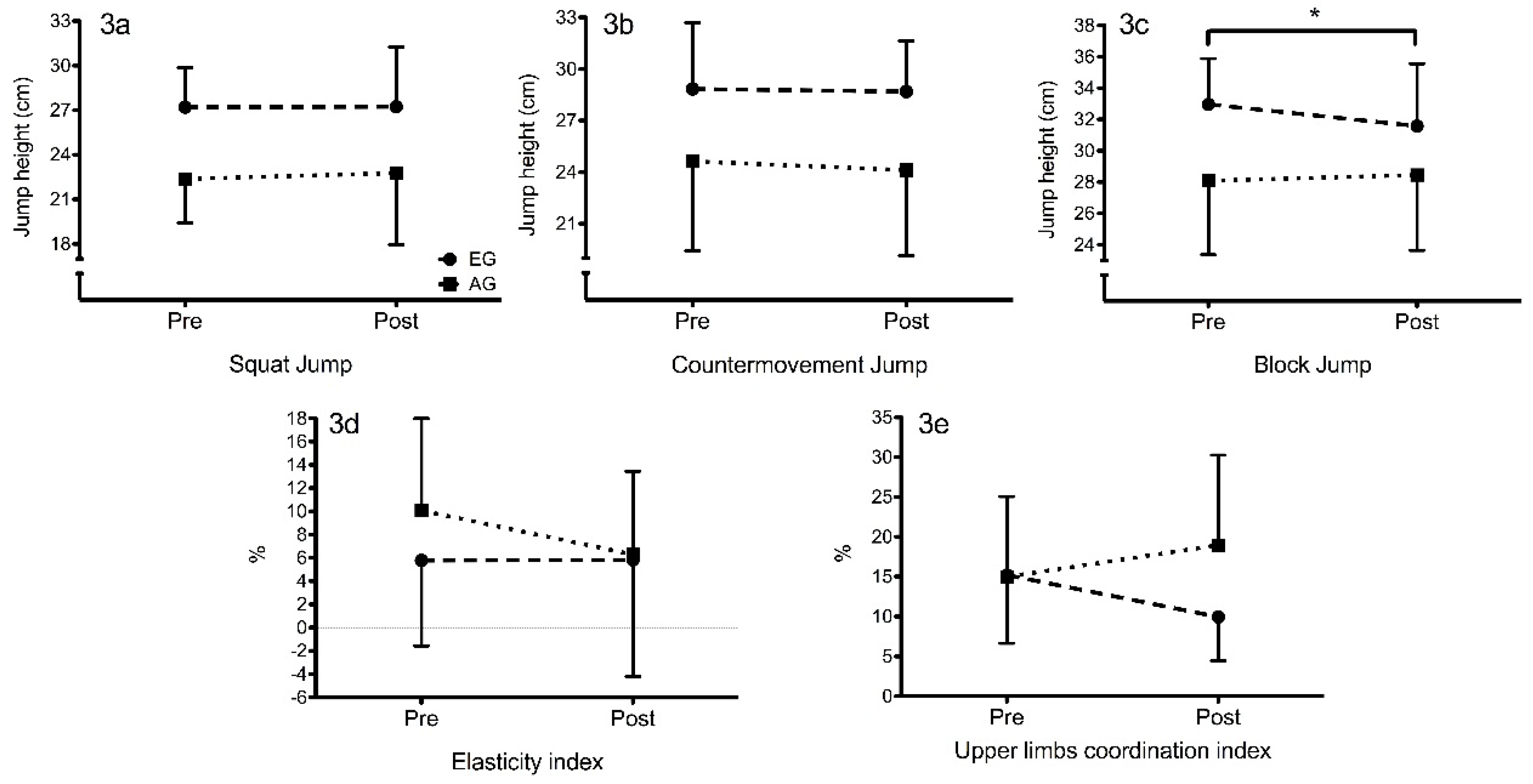Acute Effects of Block Jumps in Female Volleyball Players: The Role of Performance Level
Abstract
:1. Introduction
2. Materials and Methods
2.1. Subjects
2.2. Data Collection
2.3. Experimental Design
2.4. Statistical Analysis
3. Results
4. Discussion
5. Conclusions
Acknowledgments
Author Contributions
Conflicts of Interest
References
- Gladden, L.B.; Colacino, D. Characteristics of volleyball players and success in a national tournament. J. Sports Med. Phys. Fit. 1978, 18, 57–64. [Google Scholar]
- Lidor, R.; Ziv, G. Physical and physiological attributes of female volleyball players—A review. J. Strength Cond. Res. 2010, 24, 1963–1973. [Google Scholar] [CrossRef] [PubMed]
- Nejic, D.; Trajkovic, N.; Stankovic, R.; Milanovic, Z.; Sporis, G. A comparison of the jumping performance of female junior volleyball players in terms of their playing positions. Facta Univ Phys. Educ. Sport 2013, 11, 157–164. [Google Scholar]
- Ziv, G.; Lidor, R. Vertical jump in female and male volleyball players: A review of observational and experimental studies. Scand. J. Med. Sci Sports 2010, 20, 556–567. [Google Scholar] [CrossRef] [PubMed]
- Amasay, T. Static block jump techniques in volleyball: Upright versus squat starting positions. J. Strength Cond. Res. 2008, 22, 1242–1248. [Google Scholar] [CrossRef] [PubMed]
- Bobbert, M.F.; Gerritsen, K.G.; Litjens, M.C.; Van Soest, A.J. Why is countermovement jump height greater than squat jump height? Med. Sci Sports Exerc. 1996, 28, 1402–1412. [Google Scholar] [CrossRef] [PubMed]
- Anderson, F.C.; Pandy, M.G. Storage and utilization of elastic strain energy during jumping. J. Biomech. 1993, 26, 1413–1427. [Google Scholar] [CrossRef]
- Asmussen, E.; Bonde-Petersen, F. Storage of elastic energy in skeletal muscles in man. Acta Physiol. Scand. 1974, 91, 385–392. [Google Scholar] [CrossRef] [PubMed]
- Komi, P.V.; Bosco, C. Utilization of stored elastic energy in leg extensor muscles by men and women. Med. Sci. Sports 1978, 10, 261–265. [Google Scholar] [PubMed]
- Cavagna, G.A.; Citterio, G. Effect of stretching on the elastic characteristics and the contractile component of frog striated muscle. J. Physiol. 1974, 239, 1–14. [Google Scholar]
- Aura, O.; Komi, P.V. Effects of prestretch intensity on mechanical efficiency of positive work and on elastic behavior of skeletal muscle in stretch-shortening cycle exercise. Int. J. Sports Med. 1986, 7, 137–143. [Google Scholar] [CrossRef] [PubMed]
- Cameron-Tucker, H. The neurophysiology of tone: The role of the muscle spindle and the stretch reflex. Aust. J. Physiother. 1983, 29, 155–165. [Google Scholar] [CrossRef]
- Komi, P.V. Stretch-shortening cycle: A powerful model to study normal and fatigued muscle. J. Biomech. 2000, 33, 1197–1206. [Google Scholar] [CrossRef]
- Nicol, C.; Avela, J.; Komi, P.V. The stretch-shortening cycle: A model to study naturally occurring neuromuscular fatigue. Sports Med. 2006, 36, 977–999. [Google Scholar] [CrossRef] [PubMed]
- Sheppard, J.M.; Cronin, J.B.; Gabbett, T.J.; McGuigan, M.R.; Etxebarria, N.; Newton, R.U. Relative importance of strength, power, and anthropometric measures to jump performance of elite volleyball players. J. Strength Cond. Res. 2008, 22, 758–765. [Google Scholar] [CrossRef] [PubMed]
- Shaw, M.Y.; Gribble, P.A.; Frye, J.L. Ankle bracing, fatigue, and time to stabilization in collegiate volleyball athletes. J. Athl. Train. 2008, 43, 164–171. [Google Scholar] [CrossRef] [PubMed]
- Nikolaidis, P.T.; Gkoudas, K.; Afonso, J.; Clemente-Suarez, V.; Knechtle, B.; Kasabalis, S.; Kasabalis, A.; Douda, H.; Tokmakidis, S.; Torres-Luque, G. Who jump the highest? Anthropometric and physiological correlations of vertical jump in youth elite female volleyball players. J. Sports Med. Phys. Fit. 2017, 57, 802–810. [Google Scholar]
- Pereira, G.; Almeida, A.G.; Rodacki, A.L.; Ugrinowitsch, C.; Fowler, N.E.; Kokubun, E. The influence of resting period length on jumping performance. J. Strength Cond. Res. 2008, 22, 1259–1264. [Google Scholar] [CrossRef] [PubMed]
- Gadeken, S.B. Off-Season Strength, Power, and Plyometric Training for Kansas State Volleyball. Strength Cond. J. 1999, 21, 49–55. [Google Scholar] [CrossRef]
- Dopsaj, M.; Ćopić, N.; Nešić, G.; Sikimić, M. Jumping performance in elite female volleyball players relative to playing positions: A practical multidimensional assessment model. Serbian J. Sports Sci 2012, 6, 61–69. [Google Scholar]
- Marques, M.C.; Tillaar, R.; Vescovi, J.D.; Gonzalez-Badillo, J.J. Changes in strength and power performance in elite senior female professional volleyball players during the in-season: A case study. J. Strength Cond. Res. 2008, 22, 1147–1155. [Google Scholar] [CrossRef] [PubMed]
- Tillman, M.D.; Hass, C.J.; Brunt, D.; Bennett, G.R. Jumping and Landing Techniques in Elite Women's Volleyball. J. Sports Sci. Med. 2004, 3, 30–36. [Google Scholar] [PubMed]
- Bosco, C.; Luhtanen, P.; Komi, P.V. A simple method for measurement of mechanical power in jumping. Eur. J. Appl. Physiol. Occup. Physiol. 1983, 50, 273–282. [Google Scholar] [CrossRef] [PubMed]
- Ruiz, J.R.; Ortega, F.B.; Gutierrez, A.; Meusel, D.; Sjostrom, M.; Castillo, M.J. Health-related fitness assessment in childhood and adolescence: A European approach based on the AVENA, EYHS and HELENA studies. J. Public Health 2006, 14, 269–277. [Google Scholar] [CrossRef]
- Cohen, J. A power primer. Psychol. Bull. 1992, 112, 155–159. [Google Scholar] [CrossRef] [PubMed]
- Komi, P.V. Physiological and biomechanical correlates of muscle function: Effects of muscle structure and stretch-shortening cycle on force and speed. Exerc. Sport Sci. Rev. 1984, 12, 81–121. [Google Scholar] [CrossRef] [PubMed]
- Ortiz, A.; Olson, S.L.; Etnyre, B.; Trudelle-Jackson, E.E.; Bartlett, W.; Venegas-Rios, H.L. Fatigue effects on knee joint stability during two jump tasks in women. J. Strength Cond. Res. 2010, 24, 1019–1027. [Google Scholar] [CrossRef] [PubMed]
- Nikolaidis, P.T.; Ziv, G.; Arnon, M.; Lidor, R. Physical characteristics and physiological attributes of female volleyball players—The need for individual data. J. Strength Cond. Res. 2012, 26, 2547–2557. [Google Scholar] [CrossRef] [PubMed]
- Barnes, J.L.; Schilling, B.K.; Falvo, M.J.; Weiss, L.W.; Creasy, A.K.; Fry, A.C. Relationship of jumping and agility performance in female volleyball athletes. J. Strength Cond. Res. 2007, 21, 1192–1196. [Google Scholar] [CrossRef] [PubMed]
- Smith, D.J.; Roberts, D.; Watson, B. Physical, physiological and performance differences between Canadian national team and universiade volleyball players. J. Sports Sci. 1992, 10, 131–138. [Google Scholar] [CrossRef] [PubMed]
- Hakkinen, K. Changes in physical fitness profile in female volleyball players during the competitive season. J. Sports Med. Phys. Fit. 1993, 33, 223–232. [Google Scholar]
- Fry, A.C.; Kraemer, W.J.; Weseman, C.A.; Conroy, B.P.; Gordon, S.E.; Hoffman, J.R.; Maresh, C.M. The effects of an off-season trenght and conditioning program on starters and non-starters in women’s intercollegiate volleyball. J. Appl. Sport Sci. Res. 1991, 5, 174–181. [Google Scholar]
- Maffiuletti, N.A.; Dugnani, S.; Folz, M.; Di Pierno, E.; Mauro, F. Effect of combined electrostimulation and plyometric training on vertical jump height. Med. Sci. Sports Exerc. 2002, 34, 1638–1644. [Google Scholar] [CrossRef] [PubMed]
- Newton, R.U.; Rogers, R.A.; Volek, J.S.; Hakkinen, K.; Kraemer, W.J. Four weeks of optimal load ballistic resistance training at the end of season attenuates declining jump performance of women volleyball players. J. Strength Cond. Res. 2006, 20, 955–961. [Google Scholar] [CrossRef] [PubMed]
- Stanganelli, L.C.; Dourado, A.C.; Oncken, P.; Mancan, S.; da Costa, S.C. Adaptations on jump capacity in Brazilian volleyball players prior to the under-19 World Championship. J. Strength Cond. Res. 2008, 22, 741–749. [Google Scholar] [CrossRef] [PubMed]
- Saez Saez de Villarreal, E.; Gonzalez-Badillo, J.J.; Izquierdo, M. Optimal warm-up stimuli of muscle activation to enhance short and long-term acute jumping performance. Eur. J. Appl. Physiol. 2007, 100, 393–401. [Google Scholar] [CrossRef] [PubMed]
- Harman, E.A.; Rosenstein, M.T.; Frykman, P.N.; Rosenstein, R.M. The effects of arms and countermovement on vertical jumping. Med. Sci. Sports Exerc. 1990, 22, 825–833. [Google Scholar] [CrossRef] [PubMed]
- Nesser, T.W.; Demchak, T.J. Variations of preseason conditioning on volleyball performance. J. Exerc. Physiol. Online 2007, 10, 35–42. [Google Scholar]
- Rodacki, A.L.; Fowler, N.E.; Bennett, S.J. Vertical jump coordination: Fatigue effects. Med. Sci. Sports Exerc. 2002, 34, 105–116. [Google Scholar] [CrossRef] [PubMed]
- Palao, J.M.; Saenz, B.; Ureña, A. Effect of a learning work of the eccentric-concentric cycle on the jump capacity in volleyball. Rev. Int. Med. Cienc. Act. Fis. Deporte 2001, 1, 163–176. [Google Scholar]
- Chappell, J.D.; Herman, D.C.; Knight, B.S.; Kirkendall, D.T.; Garrett, W.E.; Yu, B. Effect of fatigue on knee kinetics and kinematics in stop-jump tasks. Am. J. Sports Med. 2005, 33, 1022–1029. [Google Scholar] [CrossRef] [PubMed]
- Barber-Westin, S.D.; Noyes, F.R.; Galloway, M. Jump-land characteristics and muscle strength development in young athletes: A gender comparison of 1140 athletes 9 to 17 years of age. Am. J. Sports Med. 2006, 34, 375–384. [Google Scholar] [CrossRef] [PubMed]
- Kernozek, T.W.; Torry, M.R.; Iwasaki, M. Gender differences in lower extremity landing mechanics caused by neuromuscular fatigue. Am. J. Sports Med. 2008, 36, 554–565. [Google Scholar] [CrossRef] [PubMed]
- Quatman, C.E.; Ford, K.R.; Myer, G.D.; Hewett, T.E. Maturation leads to gender differences in landing force and vertical jump performance: A longitudinal study. Am. J. Sports Med. 2006, 34, 806–813. [Google Scholar] [CrossRef] [PubMed]
- González Montesinos, J.L.; Caraballo Vidal, I.; Gómez Espinosa de los Monteros, R.; Fernández Santos, J.; Román Bazán, M.A. Proposal to calculate the maximun elasticity index value of lower members. Rev. Int. Med. Cienc. Act. Fis. Deporte 2010, 10, 356–368. [Google Scholar]
- Hara, M.; Shibayama, A.; Takeshita, D.; Fukashiro, S. The effect of arm swing on lower extremities in vertical jumping. J. Biomech. 2006, 39, 2503–2511. [Google Scholar] [CrossRef] [PubMed]
- Lees, A.; Vanrenterghem, J.; De Clercq, D. Understanding how an arm swing enhances performance in the vertical jump. J. Biomech. 2004, 37, 1929–1940. [Google Scholar] [CrossRef] [PubMed]
- Hara, M.; Shibayama, A.; Arakawa, H.; Fukashiro, S. Effect of arm swing direction on forward and backward jump performance. J. Biomech. 2008, 41, 2806–2815. [Google Scholar] [CrossRef] [PubMed]
- Lees, A.; Vanrenterghem, J.; De Clercq, D. The energetics and benefit of an arm swing in submaximal and maximal vertical jump performance. J. Sports Sci. 2006, 24, 51–57. [Google Scholar] [CrossRef] [PubMed]
- Sattler, T.; Hadzic, V.; Dervisevic, E.; Markovic, G. Vertical jump performance of professional male and female volleyball players: Effects of playing position and competition level. J. Strength Cond. Res. 2015, 29, 1486–1493. [Google Scholar] [CrossRef] [PubMed]
- Fleck, S.J.; Case, S.; Puhl, J.; Van Handle, P. Physical and physiological characteristics of elite women volleyball players. Can. J. Appl. Sport Sci. 1985, 10, 122–126. [Google Scholar] [PubMed]
- Spence, D.W.; Disch, J.G.; Fred, H.L.; Coleman, A.E. Descriptive profiles of highly skilled women volleyball players. Med. Sci. Sports Exerc. 1980, 12, 299–302. [Google Scholar] [CrossRef] [PubMed]
- Hedrick, M.A. Training for High Level Performance in Women’s Collegiate Volleyball: Part I Training Requirements. Strength Cond. J. 2007, 29, 50–53. [Google Scholar] [CrossRef]
- Gonzalez-Rave, J.M.; Arija, A.; Clemente-Suarez, V. Seasonal changes in jump performance and body composition in women volleyball players. J. Strength Cond. Res. 2011, 25, 1492–1501. [Google Scholar] [CrossRef] [PubMed]



| Variable | EG (n = 10) | AG (n = 11) | Δ% | p | d |
|---|---|---|---|---|---|
| Weight (kg) | 68.34 ± 7.97 | 61.55 ± 5.70 | 9.94 | 0.009 | 0.99 |
| Height (cm) | 175.70 ± 5.33 | 167.00 ± 7.87 | 4.57 | 0.036 | 1.32 |
| BMI (kg/m2) | 22.08 ± 1.88 | 22.07 ± 1.45 | 0.05 | 0.985 | 0.01 |
© 2017 by the authors. Licensee MDPI, Basel, Switzerland. This article is an open access article distributed under the terms and conditions of the Creative Commons Attribution (CC BY) license (http://creativecommons.org/licenses/by/4.0/).
Share and Cite
Brazo-Sayavera, J.; Nikolaidis, P.T.; Camacho-Cardenosa, A.; Camacho-Cardenosa, M.; Timón, R.; Olivares, P.R. Acute Effects of Block Jumps in Female Volleyball Players: The Role of Performance Level. Sports 2017, 5, 30. https://doi.org/10.3390/sports5020030
Brazo-Sayavera J, Nikolaidis PT, Camacho-Cardenosa A, Camacho-Cardenosa M, Timón R, Olivares PR. Acute Effects of Block Jumps in Female Volleyball Players: The Role of Performance Level. Sports. 2017; 5(2):30. https://doi.org/10.3390/sports5020030
Chicago/Turabian StyleBrazo-Sayavera, Javier, Pantelis Theodoros Nikolaidis, Alba Camacho-Cardenosa, Marta Camacho-Cardenosa, Rafael Timón, and Pedro R. Olivares. 2017. "Acute Effects of Block Jumps in Female Volleyball Players: The Role of Performance Level" Sports 5, no. 2: 30. https://doi.org/10.3390/sports5020030






